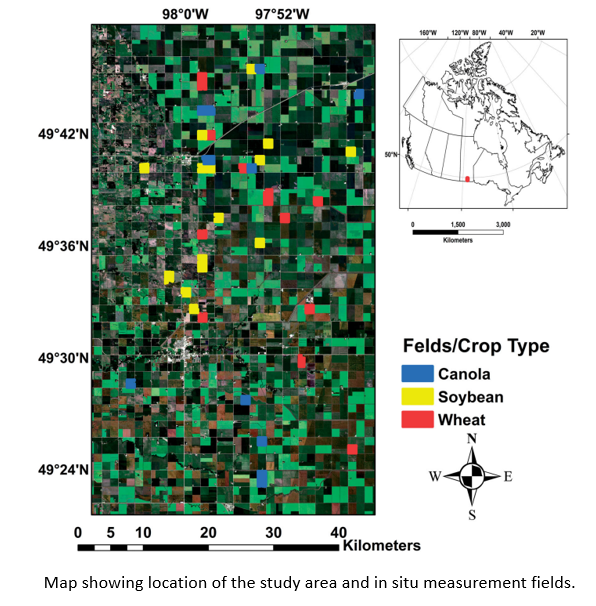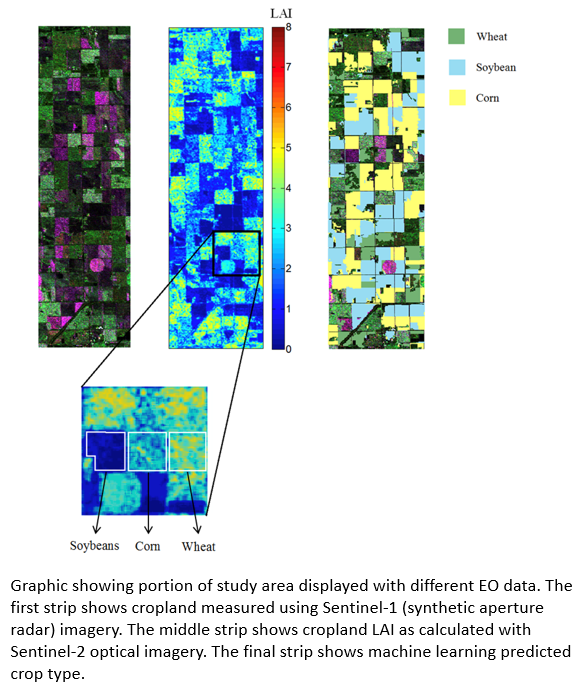Measuring Crop Characteristics from Space
Monitoring crops is important to estimate their health and yields. Our ability to monitor global cropland has improved with advancements in satellite imagery and computing capabilities. These technological improvements have resulted in a number of different monitoring methods, many of which are specialized for specific crops.
As the type of crops grown within a region of interest can vary widely, this can mean that researchers have to select a number of models to accurately model all present crops. This process can greatly increase the amount of work needed to monitor cropland throughout a growing season.
Alternatively, a researcher can limit the number of models used, but this can result in some crops being more accurately observed than others. In an effort to reduce the amount of work needed to map a variety of crops with high accuracy, recent work co-authored by NASA Harvest partner, Dr. Mehdi Hosseini, evaluated the performance of commonly used models and determined which would most effectively measure important characteristics across common crops.
Flood, drought, and other disasters can adversely impact the growing cycle and eventual yield of cropland. Knowing how global cropland is faring throughout the year is vital to informing policy interventions and market transparency. Of particular importance are major commodity crops like wheat, corn, soybean, canola, and rice. These crops form the foundation of many people’s diets and are often majority-produced in a few major exporting countries. Thus issues in one country can have a detrimental effect on the food security of a number of other countries.
Two important phenological characteristics for monitoring crop condition are leaf area index (LAI) and biomass. These variables are measurements of the crop canopy and the total amount of vegetative mass within a given volume. As leaf canopy and biomass are direct indicators of yield, these characteristics provide good early estimates of productivity.
Using a combination of optical and radar earth observation data from the European Space Agency’s Sentinel program, the team estimated LAI and biomass for 3 major commodity crops: wheat, soybeans, and canola.
Examining 50 fields in the Canadian Prairie, Canada’s agricultural breadbasket, the team tested three commonly used machine learning models: random forest, artificial neural network, and support vector machine. Each was evaluated on their performance estimating LAI and biomass for wheat, soybeans, and canola individually, as well as its ability to estimate the characteristics for all three crops together.
Each model had crops and characteristics that it estimated better than the competitor models, with the ANN model having the most accurate predictions for the widest number of crop characteristics. However, the ANN model also had a longer computation time than the other two models. Given the amount of data that is required to be processed for global crop models, speed must be factored alongside accuracy as part of model selection.
Because of its higher speed and acceptable accuracy, the random forest model was instead selected for the combined crop model. The random forest combined model was able to correctly predict both biomass and LAI for all three crops with accuracies ranging from 83 - 92%.These promising results show the model’s ability to accurately estimate important phenological characteristics of major crops within acceptable computing limits and time frames. This supports the model’s use in future evaluation of crop condition monitoring.
With the ever present threats presented by climate change and the importance of agriculture to the feeding and stability of every country on the planet, the necessity of accurate agricultural monitoring is only going to increase. The growing amount of EO data and the cloud processing capabilities to analyze it provide numerous opportunities to test methods of crop condition observation at larger and larger scales.
You can read the original study here and learn more about Dr. Hosseini’s research activities in this recently published People of Harvest profile.


